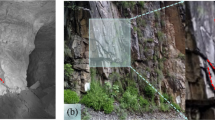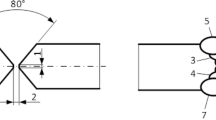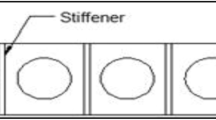Abstract
In the first part of the paper, the use of circumferentially cracked round bars (CRB geometry) for characterizing fracture toughness of a ductile material, namely copper, is assessed experimentally through a comparison with the single edge notched bend (SENB) geometry. The J R curve method with multiple-specimens was applied, but, as unstable cracking appeared very early in the CRB specimen, an engineering definition of fracture toughness was not pertinent. Unloaded specimens were analyzed metallographically to determine the CTOD at physical cracking initiation. The fracture toughness measured using the CRB geometry was 50% larger than using the SENB geometry. The second part of the paper aims at justifying this difference of fracture toughness at cracking initiation. Finite element simulations revealed a slightly higher constraint in the SENB specimens. The main difference between the two specimen geometries lies in a 50% larger extension of the finite strain zone with respect to the CTOD in the case of the SENB specimens. Based on the observation that, in the studied material, the critical CTOD is one order of magnitude larger than the void spacing, we conclude that the geometry dependence of the fracture toughness is caused by the difference in the finite strain zone extension rather than by a stress triaxiality effect.
Similar content being viewed by others
References
ABAQUS Version 5.7 (1997) User's Manual, Hibbit, Karlsson & Sorensen, Providence, R.I.
Anderson, T.L. (1989). Crack tip parameters for large scale yielding and low constraint configurations. International Journal of Fracture 41, 79–104.
Anderson, T.L. (1995). Fracture Mechanics -Fundamentals and Applications, CRC Press, Boca Raton.
Anderson, T.L. and Dodds, R.H., Jr. (1993). Simple constraint correction for subsize fracture toughness specimens. Small Specimen Test Techniques Applied to Nuclear Reactor Vessel Thermal Annealing and Plant Life Extension, ASTM STP 1204 (Edited by W. R. Corwin, F. M. Haggag and W. L. Server), American Society for Testing and Materials, Philadelphia.
ASTM Standard E1737-96 (1996). Standard Test Method J-Integral Characterization of Fracture Toughness. Annual Book of ASTM Standards, Section 3, Volume 03.01, American Society for Testing and Materials, Philadelphia.
Benthem, J.P. and Koiter, W.T. (1973). Asymptotic approximations to crack problems. Methods of Analysis and Solutions of Crack Problems (Edited by G. C. Shi), Noordhoft International Publishing, Groningen, 131–178.
Beremin, F.M. (1981). Calculation and experiment on axisymetrically cracked tensile bars: prediction of initiation, stable crack growth and instability. Transactions of the 6th International SMIRT Conference, Paper L/G, No. 2/3, Paris.
Bergkvist, H. and Huong, G.L. (1977). J-integral related quantities in axisymmetric cases. International Journal of Fracture 13, 556–558.
Bridgman, P.W. (1952). Studies in Large Plastic Flow and Fracture. McGraw-Hill, New-York.
Broberg, K.B. (1971). Crack-growth criteria and non-linear fracture mechanics. Journal of the Mechanics and Physics of Solids 19, 407–418.
Brocks, W. and Schmitt, W. (1994). The second parameter in JR curve: constraint or triaxiality ? Proceedings of the Second Symposium on Constraint Effects, ASTMSTP 1244 (Edited by M. T. Kirk and A. Bakker) American Society for Testing and Materials, Philadelphia, 209–231.
Budiansky, B., Hutchinson, J.W. and Slutsky S. (1982). Void growth and collapse in viscous solids. Mechanics of Solids, The Rodney Hill 60th Anniversary Volume (Edited by H. G. Hopkins and M. J. Sewell), Pergamon Press, London, 13–45.
Budiansky, B. and Rice, J.R. (1973). Conservation laws and energy-release rates. Journal of Applied Mechanics, 20–203.
d'Escatha, Y. and Devaux, J.C. (1979). Numerical study of initiation, stable crack growth and maximum load with a ductile fracture criterion based on the growth of holes. Elastic Plastic Fracture, ASTM STP 668 (Edited by J. D. Landes, J. A. Begley and G. A. Clarke), American Society for Testing and Materials, Philadelphia, pp. 229–248.
Devaux, J.C., Rousselier, G., Mudry, F. and Pineau, A. (1985). An experimental program for the validation of local ductile fracture criteria using axisymmetrically cracked bars and compact tension specimens. Engineering Fracture Mechanics 21, 273–283.
ESIS (1992). ESIS Procedure for Determining the Fracture Behaviour of Materials. European Structural Integrity Society.
Gage, G. (1996). Measurement of transition fracture behaviour using miniature-scale specimens. Advances in Fracture Mechanics -Proceedings of the TAGSI Symposium, TWI Cambridge, 9- 10 January 1996.
Garrison, W.M., Jr., Wokcieszynski, A.L., and Iorio, L.E. (1997). Effects of inclusion distribution on the fracture toughness of structural steels. Recent Advances in Fracture (Edited by R. K. Mahidhara, A.B. Geltmacher, P. Matic, and K. Sadananda), The Minerals, Metals, and Materials Society.
Giovanola, J.H., Homma, H., Lichtenberger, M., Crocker, J.E. and Klopp, R.W. (1994). Fracture toughness measurements using small cracked round bars. Constraint Effects in Fracture: Theory and Applications, ASTM STP 1244 (Edited by M. Kirk and A. Bakker), American Society for Testing and Materials, Philadelphia.
Giovanola, J.H., Klopp, R.W., Crocker J.E., Alexander, D.J., Corwin, W.R. and Nanstad, R.K. (1997). Using small cracked round bars to measure the fracture toughness of a pressure vessel steel weldment: a feasibility study.. Small Specimen Test Techniques, ASTM STP 1329 (Edited by W. R. Corwin, S. T. Rosinski and E. van Walle), American Society for Testing and Materials, Philadelphia.
Gologanu, M., Leblond, J.-B., Perrin, G. and Devaux, J. (1995). Recent extensions of Gurson's model for porous ductile metals. Continuum Micromechanics (Edited by P. Suquet), Springer-Verlag, Berlin.
Hawley, R.H., Duffy, J. and Shih, C.F. (1985). Dynamic notched round bar testing. ASM Metal Handbook -Mechanical Testing, American Society for Metals, 9th edition, 8, 275–282.
Hom, C.L. and McMeeking, R.M. (1989) Three-dimensional void growth before a blunting crack tip. Journal of the Mechanics and Physics of Solids 37, 395–415.
Huang, Y. (1991). Accurate dilatation rates for spherical voids in triaxial stress fields. Journal of Applied Mechanics 58, 1084–1085.
Ibrahim, R.N. and Stark, H.L. (1987). Validity requirements for fracture toughness measurements obtained from small circumferentially notched cylindrical specimens. Engineering Fracture Mechanics 28, 455–460.
Ibrahim, R.N. and Stark, H.L. (1990). Establishing K IC from eccentrically fatigue cracked small circumferentially grooved cylindrical specimens. International Journal of Fracture 44, 179–188.
Koplik, J. and Needleman, A. (1988). Void growth and coalescence in porous plastic solids. International Journal of Solids and Structures 24, 835–853.
Lam, Y.C. and Ibrahim, R.N. (1994). Improvement of the fracture toughness of an aluminium alloy. Fatigue and Fracture of Engineering Materials and Structures 17, 277–284.
Li, D.M. and Bakker, A. (1997). Fracture toughness evaluation using circumferentially-cracked cylindrical bar specimens. Engineering Fracture Mechanics 57, 1–11.
Lucon, E. (1990). Fracture toughness testing using small cylindrical specimens with ring-shaped cracks. Proceedings of ECF8 Fracture Behaviour and Design of Materials and Structures (Edited by D. Firrao), EMAS, London, Volume 2, 1077–1082.
McClintock, F.A. (1968). A criterion for ductile fracture by the growth of holes. Journal of Applied Mechanics 35, 363–371.
McMeeking, R.M. (1977). Finite deformation analysis of crack-tip opening in elastic-plastic materials and implication for fracture. Journal of the Mechanics and Physics of Solids 25, 357–381.
Moran, B., Asaro, R.J. and Shih, C.F. (1991). Effects of material rate sensitivity and void nucleation on ductile fracture initiation in a circumferentially cracked bar. Metallurgical Transactions A 22A, 161–179.
Neale, B.K. (1995). The analytical fracture behaviour of a bar in tension containing a circumferential edge crack. Internal Report TEMP/REP/0131/94, Nuclear Electric, England.
Neale, B.K. (1996). The fracture behaviour of a circumferentially cracked bar in tension. Advances in Fracture Mechanics -Proceedings of the TAGSI Symposium, TWI Cambridge, 9- 10 January 1996.
Norris, D.M., Moran, B., Scudder, J.K. and Quinones, D.F. (1978). A computer simulation of the tension test. Journal of the Mechanics and Physics of Solids 26, 1–19.
O'Dowd, N.P. and Shih, C.F. (1991a). Family of crack-tip fields characterized by a triaxiality parameter-I. Structure of fields. Journal of the Mechanics and Physics of Solids 39, 898–937.
O'Dowd, N.P. and Shih, C.F. (1991b). Family of crack-tip fields characterized by a triaxiality parameter-II. Fracture applications. Journal of the Mechanics and Physics of Solids 39, 939–963.
Pardoen, T. and Delannay, F. (1996). Critical assessment of the application of the J-integral and CTOD concepts to circumferentially cracked copper bars. International Journal of Fracture 79, 373–391.
Pardoen, T. and Delannay, F. (1998). Assessment of void growth models from porosity measurements in colddrawn copper bars. Metallurgical and Materials Transactions A 29A, 1895–1909.
Pardoen, T. and Delannay, F. (1999). A method for determining the CTOD at cracking initiation. Engineering Fracture Mechanics, in press.
Pardoen, T. and Hutchinson, J.W. (1999). Improved model for the growth and coalescence of voids in elastoplastic solids, Harvard MECH Report 356.
Pardoen, T., Doghri, I. and Delannay, F. (1998). Experimental and numerical comparison of void growth models and void coalescence criteria for the prediction of ductile fracture in copper bars. Acta Materialia 46, 541–552.
Pineau, A. (1992). Global and local approaches of fracture -Transferability of laboratory test results to components. Topics in Fracture and Fatigue (Edited by A.S. Argon) Springer-Verlag, Berlin, pp. 197–234.
Rice, J.R. (1968). A path independent integral and approximate analysis of strain concentration by notches and cracks. Journal of Applied Mechanics 35, 379–386.
Rice, J.R. and Johnson, M.A. (1970). The role of large crack tip geometry changes in plane-strain fracture. Inelastic Behaviour of Solids (Edited by M. F. Kanninen, W. F. Adler, A. R. Rosenfield and R. I. Jaffee), McGraw-Hill, New York, pp. 641–672.
Rice, J.R. and Tracey, D.M. (1969). On the ductile enlargement of voids in triaxial stress fields. Journal of the Mechanics and Physics of Solids 17, 201–217.
Ritchie, R.O. and Thompson, A.W. (1985). On macroscopic and microscopic analyses for crack initiation and crack growth toughness in ductile alloys. Metallurgical Transactions A 16A, 233–248.
Scibetta, M. and Chaouadi, R. (1997). Fracture toughness derived from circumferentially cracked bars. Small Specimen Test Techniques, ASTM STP 1329 (Edited by W. R. Corwin, S. T. Rosinski and E. van Walle), American Society for Testing and Materials, Philadelphia.
Scibetta, M., Chaouadi, R. and Van Walle, E. (1998). Fracture toughness evaluation of circumferentially-cracked round bars: theoretical aspects (submitted).
Shih, C. F. (1983) Tables of Hutchinson-Rice-Rosengren Singular Field Quantities, MRL E-147, Division of Engineering, Brown University, Providence, R.I.
Shih, C.F., Moran, B. and Nakamura, T. (1986). Energy relaese rate along a three-dimensional crack front in a thermally stressed body. International Journal of Fracture 30, 79–102.
Stark, H.L. and Ibrahim, R.N. (1986). Estimating fracture toughness from small specimens. Engineering Fracture Mechanics 25, 395–401.
Tvergaard, V. (1990). Material failure by void growth to coalescence. Advances in Applied Mechanics 27, 83–151.
Tvergaard, V. and Hutchinson, J.W. (1992). The relationship between crack growth resistance and fracture process parameters in elastic-plastic solids. Journal of the Mechanics and Physics of Solids 40, 1377–1397.
Xia, L. and Shih, C.F. (1995a). Ductile crack growth -I. A numerical study using computational cells with microstructurally-based length scales. Journal of the Mechanics and Physics of Solids 43, 233–259.
Xia, L. and Shih, C.F. (1995b). Ductile crack growth -II. Void nucleation and geometry effects on macroscopic fracture behaviour. Journal of the Mechanics and Physics of Solids 43, 1953-1981.
Xia, L. and Shih, C.F. (1996). Ductile crack growth -III. Transition to cleavage fracture incorporating statistics. Journal of the Mechanics and Physics of Solids 44, 603–639.
Author information
Authors and Affiliations
Rights and permissions
About this article
Cite this article
Pardoen, T., Scibetta, M., Chaouadi, R. et al. Analysis of the geometry dependence of fracture toughness at cracking initiation by comparison of circumferentially cracked round bars and SENB tests on Copper. International Journal of Fracture 103, 205–225 (2000). https://doi.org/10.1023/A:1007668030117
Issue Date:
DOI: https://doi.org/10.1023/A:1007668030117




